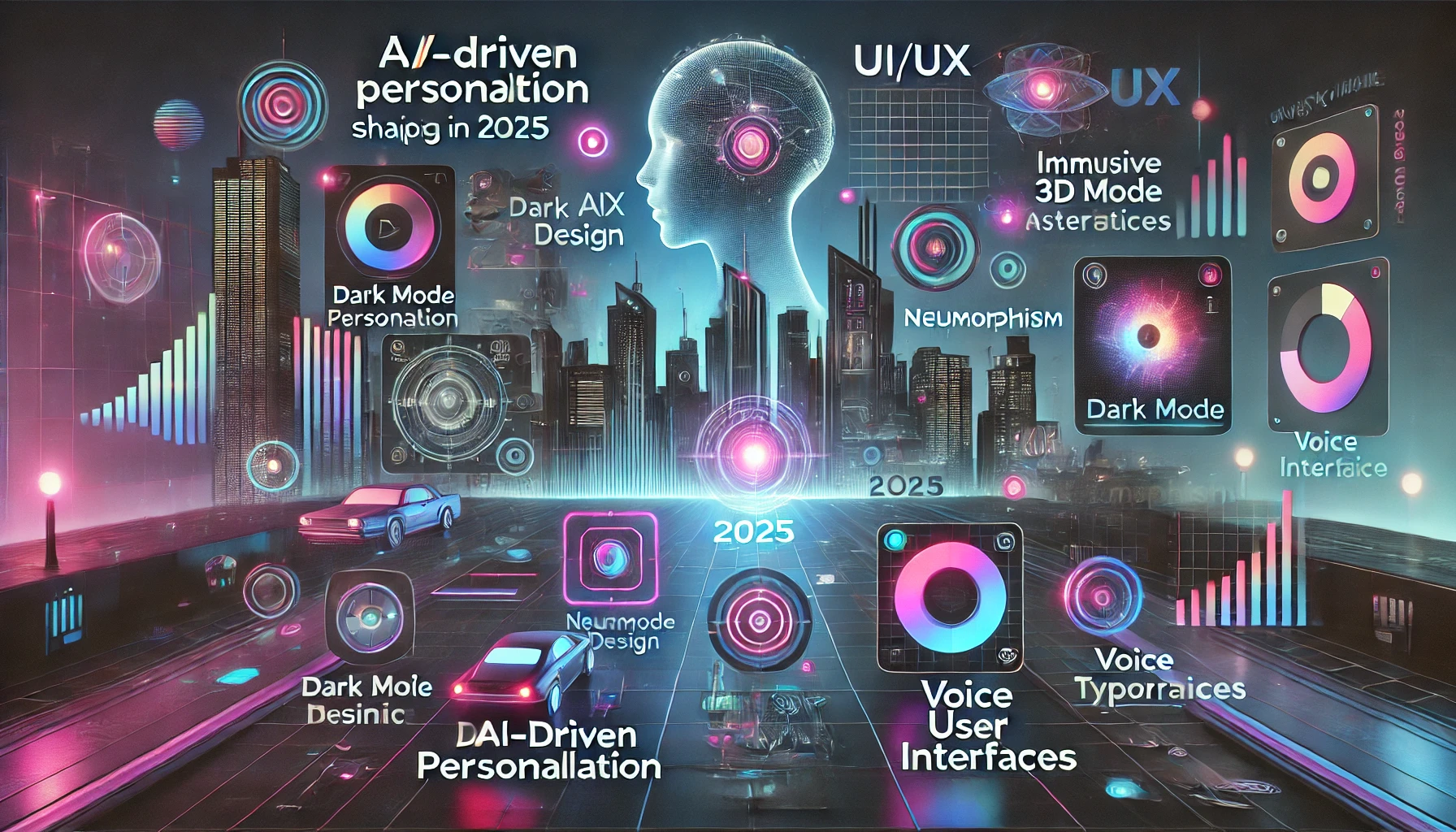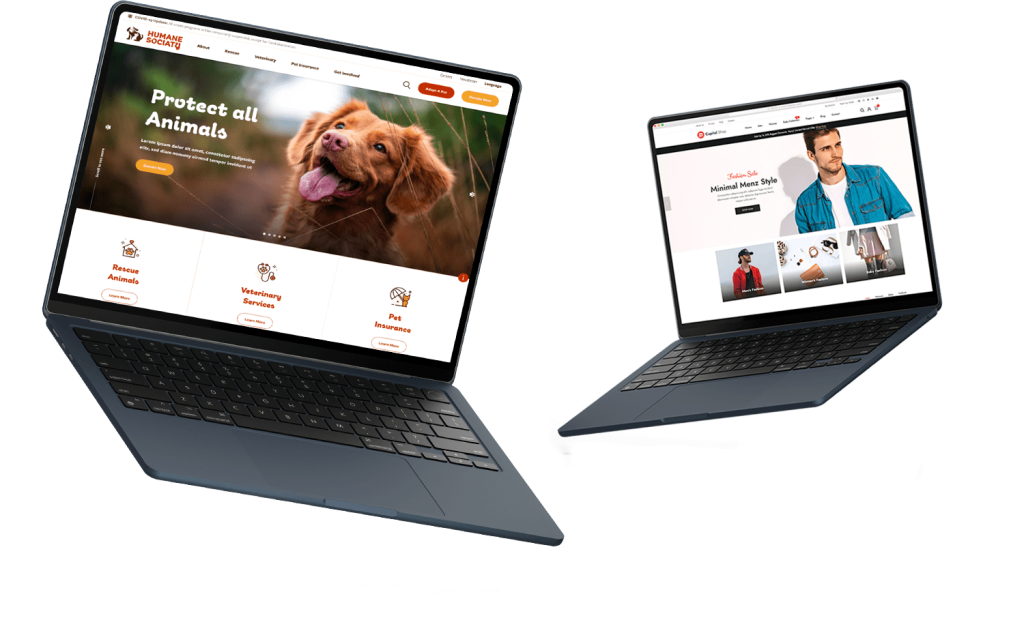As we step into 2025, UI/UX design agency experts are witnessing rapid transformations in digital experiences. With the growing importance of user-centric designs, brands are focusing on creating intuitive, immersive, and aesthetically appealing interfaces. The integration of AI, immersive technologies, and personalization is redefining how users interact with websites and applications.
In this blog, we explore the top UI/UX trends that are already shaping the web in 2025 and how they can elevate your digital presence.
-
AI-Powered Personalization
Artificial intelligence (AI) leads the charge of UI/UX innovation, allowing websites and apps to adapt to individual user behaviors.
- Dynamic UI Adjustments: AI-powered interfaces can modify layouts, colors, and content based on user preferences.
- Predictive User Experience: Machine learning anticipates user needs, offering personalized recommendations and automating interactions.
- Conversational AI: AI-driven chatbots and virtual assistants provide instant responses, enhancing engagement and user satisfaction.
Personalization powered by AI is no longer a luxury but a necessity for businesses looking to enhance user retention.
-
Immersive 3D and AR/VR Interfaces
As hardware capabilities advance, the use of 3D elements and augmented/virtual reality (AR/VR) in UI/UX design is becoming more prevalent.
- Augmented Reality Shopping: E-commerce platforms integrate AR for virtual try-ons, helping customers visualize products before purchasing.
- 3D Web Design: Websites with interactive 3D models create engaging experiences without requiring additional applications.
- Virtual Reality Interfaces: Immersive VR applications enhance training simulations, real estate tours, and gaming experiences.
These enhancements push digital experiences beyond static interfaces, making interactions more engaging and realistic.
-
Dark Mode and Low-Light UI
Dark mode has changed from a trend to a standard feature in modern UI/UX design.
- Reduces Eye Strain: Dark backgrounds reduce screen glare and improve readability in low-light environments.
- Enhances Aesthetics: Dark mode creates a sleek, modern appearance, making content stand out more effectively.
- Battery Efficiency: OLED and AMOLED screens consume less power when displaying dark themes, extending battery life for mobile users.
Websites and apps are offering adaptive themes that permit users to switch between light and dark modes based on preference.
-
Voice User Interfaces (VUI)
Voice interactions are reshaping how users engage with digital platforms. Voice User Interfaces (VUI) are streamlining navigation and accessibility.
- Voice Search Optimization: More users rely on voice commands for search queries, making websites optimize for conversational keywords.
- Hands-Free Navigation: Voice commands enable touch-free interactions, enhancing accessibility.
- Multimodal Interfaces: Combining voice, text, and gesture controls for a more natural and intuitive experience.
VUI is particularly useful in smart home devices, automotive applications, and hands-free browsing experiences.
-
Microinteractions and Animations
Subtle animations and microinteractions enhance the user experience by providing feedback and improving navigation.
- Button Hover Effects: Enhances engagement by visually responding to user actions.
- Loading Animations: Reduces perceived wait time with creative, interactive loaders.
- Scrolling Effects: Parallax and motion animations create depth and engagement.
These small yet impactful details contribute to a more interactive and enjoyable browsing experience.
-
Neumorphism and Soft UI Design
Neumorphism is a fusion of skeuomorphism and flat design, creating soft, realistic-looking interfaces.
- Subtle Shadows and Highlights: Enhances depth and visual appeal.
- Minimalistic and Elegant Look: Focuses on simplicity while maintaining a futuristic aesthetic.
- User-Friendly Interaction: Buttons and elements appear pressable, improving usability.
Neumorphism is gaining popularity in dashboards, mobile applications, and product landing pages.
-
Data-driven UX and Analytics-Based Design
With increased competition, businesses are leveraging data to improve user experience (UX) strategies.
- A/B Testing for UI Elements: Testing multiple designs to determine what works best.
- Heatmaps and User Behavior Analysis: Understanding user interaction patterns for better design decisions.
- Real-Time UX Adjustments: AI-driven platforms optimize interfaces based on real-time user actions.
By utilizing analytics, brands can refine their digital experiences to maximize engagement and conversions.
-
Hyper-Minimalism in UI
As attention spans shorten, hyper-minimalism is becoming a dominant UI trend.
- Clutter-Free Interfaces: Eliminates unnecessary elements, focusing on essential content.
- Monochromatic and Pastel Color Palettes: Enhances simplicity and elegance.
- Bold Typography: Prioritizes readability and visual impact.
Hyper-minimalism improves usability by ensuring intuitive navigation without distractions.
-
Biometric Authentication and Enhanced Security UI
Security is a growing concern, and biometric authentication is shaping UI/UX designs for better user protection.
- Facial Recognition and Fingerprint Scanners: Ensuring secure and seamless logins.
- Passwordless Authentication: Removing the need for traditional passwords with biometric security.
- Multi-Factor Authentication (MFA): Strengthening security layers for sensitive applications.
Designing seamless yet secure authentication processes improves both UX and data protection.
-
Sustainable and Eco-Friendly UI Design
Sustainability is influencing digital design practices. Eco-friendly UI/UX trends focus on optimizing energy consumption and ethical web design.
- Low-Impact Color Schemes: Darker and muted tones reduce energy usage on screens.
- Efficient Code and Lightweight Websites: Faster-loading sites consume fewer resources.
- Accessibility-Focused Designs: Ensuring inclusivity for users of all abilities.
Brands adopting sustainable UI practices demonstrate responsibility while enhancing digital performance.
Why Choose Speed Dot 360 for UI/UX Design Services?
At Speed Dot 360, we are a leading UI/UX design agency committed to crafting modern, engaging, and user-friendly digital experiences. Our proficiency ensures that your business stays ahead with the latest design trends, offering:
- AI-driven UI enhancements for personalized experiences.
- Immersive 3D and AR-based interfaces that engage users.
- Minimalist and accessibility-focused designs for seamless navigation.
- Data-backed design optimizations for maximum user retention.
Partner with us to future-proof your digital presence with cutting-edge UI/UX solutions.
Conclusion
The UI/UX trends of 2025 are already shaping the digital landscape, emphasizing personalization, accessibility, and immersive experiences. From AI-driven interfaces to sustainable design, businesses must adapt to these trends to stay competitive.
As a trusted UI/UX design agency, Speed Dot 360 helps businesses integrate these innovations into their websites and applications. Whether you’re revamping your digital platform or starting fresh, our experts ensure that your UI/UX strategy is future-proof and engaging.
Stay ahead of the curve—contact Speed Dot 360 today to elevate your digital experience!
Frequently Asked Questions (FAQs)
-
What are the biggest UI/UX trends in 2025?
The biggest UI/UX trends in 2025 include AI-powered personalization, immersive 3D and AR/VR interfaces, dark mode adaptation, voice user interfaces (VUI), and hyper-minimalistic design. These trends focus on creating seamless, user-friendly, and visually engaging digital experiences.
-
How is AI transforming UI/UX design?
AI is enhancing UI/UX by providing personalized user experiences, predictive content recommendations, automated chatbots, and real-time design optimizations. It helps businesses create more intuitive and efficient digital interactions.
-
Why is dark mode becoming a standard feature?
Dark mode reduces eye strain, enhances visual appeal, and improves battery efficiency for OLED and AMOLED screens. Many users prefer dark mode as it offers a modern and comfortable browsing experience.
-
What role does accessibility play in UI/UX design?
Accessibility ensures that digital experiences are inclusive for all users, including those with disabilities. Features like voice navigation, alt text for images, and keyboard-friendly interfaces help improve usability and compliance with web accessibility standards.
-
How can businesses stay ahead with UI/UX trends?
Businesses can stay ahead by partnering with a UI/UX design agency like Speed Dot 360, conducting regular user experience audits, implementing data-driven design decisions, and staying updated with emerging technologies like AI, AR/VR, and biometric authentication.





